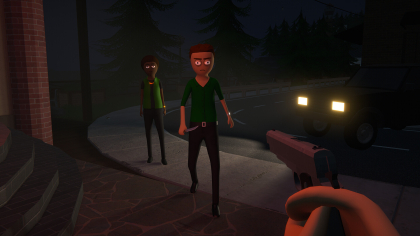Navigating the Layers of Immersive Reality in Schedule I
A Journey Begins
I must confess that when I first downloaded Schedule I Game, I felt a burst of anticipation mixed with curiosity. My initial impression was that I was stepping into a multidimensional adventure where every element was crafted with care. From the outset, the game intrigued me with its unique blend of old-school influences and fresh, user-friendly innovations. What drew me in was not just the promise of engaging challenges but the subtle commitment to narrative depth that hinted at a world waiting to be explored.
Immersive Mechanics
The gameplay of Schedule I revealed itself to be both intricate and rewarding. I found myself navigating through various systems that demanded both strategic thinking and on-the-spot reactions. The mechanics are designed in a way that every action carries weight and consequence. One of my favorite aspects was how the game marries classic control schemes with modern responsiveness. As I progressed, I encountered puzzles that required precise maneuvering and real-time adjustments. The satisfaction of overcoming these hurdles is reminiscent of long-lost experiences in retro gaming, yet it feels entirely fresh in today’s context.
Visual Mastery
The aesthetics are a standout component, and I was pleasantly surprised by the visual narrative of Schedule I. Every scene is meticulously designed, reflecting a dedication to detail that elevates the overall experience. The art style manages to be both nostalgic and futuristic at the same time, with carefully chosen color palettes and meticulously crafted environments. I found that even the smallest elements—from ambient lighting to the subtle motion of background animations—contribute to a living, breathing world. The use of shadows and reflections provided an extra layer of depth without becoming overwhelming, making me appreciate the refined artistic choices made by the developers.
Audio Marvel
Another facet that deeply resonated with me was the auditory experience. The sound design in Schedule I is nothing short of exceptional. As I explored various environments, I often paused to listen to the soundscapes that ranged from subtle, almost whispered ambient textures to bold, thematic tracks during moments of high tension. The background music, carefully synchronized with the gameplay, enhances every twist and turn of the narrative. I especially appreciated how the game employed sound cues to signal upcoming challenges, allowing me to adjust my strategy even before I fully comprehended the situation. In moments of quiet, the delicate environmental sounds provided a peaceful interlude that made the experience all the more immersive.
Narrative Path
For me, the story behind Schedule I is one of its most compelling aspects. Throughout my journey I found myself deeply engaged in the unfolding plot that was filled with unexpected twists and memorable characters. The narrative isn’t driven by a simple hero’s journey; instead, it challenges the concept of morality through intricate dilemmas and decision-making scenarios. I must say, every dialogue exchange resonated as the characters were given ample personality and depth. The storytelling is both subtle and impactful, pushing me to consider the ramifications of my choices in real time. Often, I felt as if I were co-authoring the story, with each decision leading to unforeseen consequences that made each playthrough feel distinctly personal.
Community Engagement
Connecting with fellow players has been a significant part of my experience with Schedule I. The game isn’t solely a solitary pursuit; its design encourages a vibrant community culture. I found that sharing experiences, strategies, and personal insights with others added an entirely new layer to the game. Throughout my journey, I frequented in-game forums and discussion boards where players exchanged clever tactics and artistic praise. These platforms not only enriched my gameplay but also broadened my perspective by exposing me to other innovative approaches to the game’s challenges. The developers’ willingness to incorporate community feedback is evident in updates and feature tweaks, making every session feel like a well-honed evolution of the original product.
Strategic Depth
The layers of strategy inherent in Schedule I kept my mind engaged throughout lengthy gaming sessions. Each level demands a careful balance between planning and adaptability. I was particularly impressed with how the game seamlessly blends combat, exploration, and problem-solving elements. Every player must decide how to allocate scarce resources while managing immediate threats. This aspect of resource management forces me to think critically about every action I take. There are moments when the game’s challenges require a more cautious approach, while at other times a bold strategy is perfectly rewarded. Overall, the design encourages experimentation and learning from past encounters, a feature that continually pushes me to refine my strategies and approach the game with renewed vigor.
Interface Innovation
One of the highlights I would mention is the interface. In a time when many games overwhelm players with cluttered screens and a barrage of notifications, Schedule I opted for a minimalist design that emphasizes clarity and simplicity. I was able to quickly adapt to the layout, which is both intuitive and visually appealing. Every icon and menu option appears precisely when needed, streamlining my journey through the interface. This thoughtful design fosters a more immersive experience, as I spent less time fumbling through menus and more time engaged with the game itself. The responsive controls combined with the well-thought-out user experience prove that even complex systems can be accessible when handled with care.
Adaptive Environment
What impressed me the most was the game’s dynamic environment. The ever-changing world of Schedule I isn’t static; it reacts to player decisions and in-game events in subtle yet perceptible ways. From weather conditions affecting visibility to the shifting moods of virtual cities, every detail contributes to the sense of realism. As I traveled from one location to another, I began to appreciate how the developers integrated natural phenomena into the gameplay. For example, the transformation of day into night governs not only the visual tones but influences enemy behavior and environmental hazards. This adaptability keeps me on my toes, ensuring that no two gameplay sessions are exactly alike. I often found myself pausing to admire the small touches that make the virtual world feel alive and responsive to my actions.
Resource and Time Management
Another element that captured my attention was the game’s resource management system. This aspect of Schedule I is particularly engaging because it requires me to balance long-term planning with immediate tactical decisions. I must monitor and allocate resources carefully—whether it is energy, equipment, or in-game currency—to navigate through various challenges. Every encounter is an opportunity to learn and perfect my strategy, and there are several instances where I had to make tough choices about how to best utilize my limited assets. The design encourages thoughtful decision-making; even seemingly minor choices can have far-reaching consequences in the virtual world. This pressure to manage everything intelligently has sparked many late-night sessions where I sought to perfect every nuance of my resource strategy.
User-Driven Evolution
One aspect that I find particularly compelling is the game’s willingness to evolve based on user interaction. The developers have demonstrated genuine interest in player feedback, which makes every update feel like a collaborative upgrade to the overall experience. I have observed the game transform over time as new features were integrated and existing mechanics refined. Through regular patches and updates, Schedule I has managed to maintain a vibrant ecosystem of content that continuously challenges my expectations. I was particularly fascinated by how sometimes obscure community suggestions later found their way into the official design. This seamless integration of player ideas and developer vision makes the game feel like a living, evolving project rather than a static release from the past.
Personal Evolution Through Gameplay
My journey with Schedule I has been as much about self-discovery as it has been about mastering the game itself. Each challenge I encountered forced me to adapt and think critically about my actions. Over time, I noticed a shift in my own strategic habits—I became more patient, more methodical, and learned to appreciate the beauty of uncertainty. There were moments when the game presented unexpected threats, and it was precisely those situations that contributed most to my personal growth as a player. I realized that the game’s design does not merely test reflexes; it cultivates a mindset where every decision is a blend of intuition and calculated risk. As I navigated through the multifaceted layers of the gameplay, I began to see parallels between the challenges in the game and the challenges of real-life decision-making, an observation that enriched my experience even further.
Exploration of Hidden Depths
The world of Schedule I is replete with secrets waiting to be discovered by those willing to invest time and effort. I remember spending hours wandering off the beaten path, driven by a desire to uncover hidden lore and easter eggs placed meticulously throughout the game. Every secret area discovered felt like a personal trophy, a testament to the game’s intricacy that rewards exploration beyond the obvious. I enjoyed piecing together various clues embedded in environmental elements and random dialogues, each lead gradually assembling into a coherent, albeit mysterious, narrative. This hidden depth has kept me returning to the game, as there always seems to be a new corner to turn or a forgotten passage waiting to be explored. What makes these discoveries even more compelling is the layered storytelling that invites players to rethink their understanding of the entire game world with every new find.
How to Download and Play Schedule I on Different Platforms
Schedule I is a free game available on PC, Mac, Console, and Mobile. It supports cross-platform play and offers a simple way to jump into the action. In this guide, you will learn where to download, how to install, and what you need to start playing Schedule I.
Where to Download and Play Schedule I
Windows PC: Schedule I is fully supported on Windows. You can download the game directly from the official website using the provided installer.
Mac: The game is available on macOS. Visit the official website to download the Mac version and make sure your system meets the necessary requirements.
Consoles: Schedule I is available on major consoles. PlayStation users can download the game from the PlayStation Store, and Xbox users can find it in the Microsoft Store. The game is designed to run smoothly on the latest console hardware.
Mobile Devices: Schedule I is also available on mobile platforms. Android users can download it from the Google Play Store, while iOS users can visit the App Store. The mobile version is optimized for touch controls and portable play.
How to Install Schedule I
To install Schedule I, simply download the game from the official source for your device. For PC and Mac, run the installer after the download is complete. On consoles and mobile, follow the standard installation procedure of the respective digital store.
System Requirements
For PC, Schedule I requires at least an Intel Core i3 processor, 8 GB of RAM, and a DirectX 11 compatible GPU for smooth gameplay. Mac users should check that they have the latest version of macOS installed. Android devices need to support a 64-bit operating system and run a recent Android version to ensure compatibility.
Cheats and Mods
Using cheats or mods in Schedule I is strictly prohibited. Any attempt to use them can lead to penalties, such as a permanent ban. It is always best to play the game fairly.
Unblocked Version
Schedule I cannot be played unblocked in locations with network restrictions, like schools or workplaces. If you face such restrictions, you might need to use a VPN or cloud gaming services to access the game, but be aware that these methods might violate local rules.
Enjoy the free download, install, and play experience with Schedule I. Have fun, and always play fair!
To download the app, you will get links to the Official Website and/or official digital markets.




























